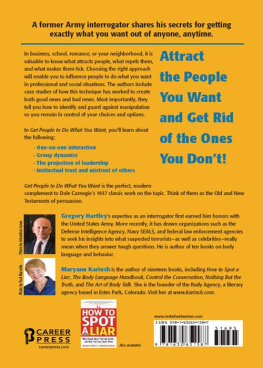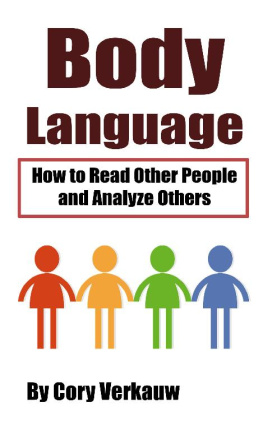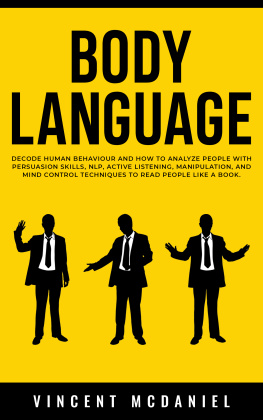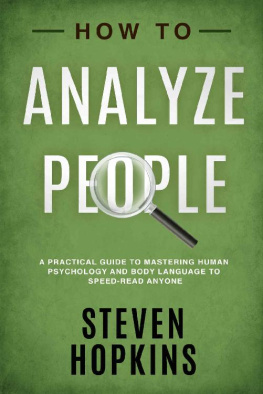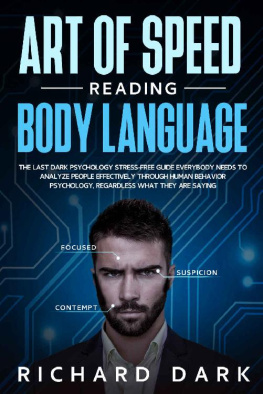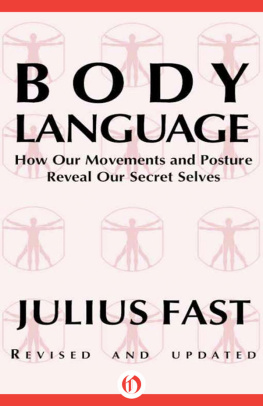The Art of Body Talk
The Art of Body Talk
How to Decode Gestures, Mannerisms, and Other Non-Verbal Messages
GREGORY HARTLEY AND MARYANN KARINCH

Copyright 2017 by Gregory Hartley and Maryann Karinch
All rights reserved under the Pan-American and International Copyright Conventions. This book may not be reproduced, in whole or in part, in any form or by any means electronic or mechanical, including photocopying, recording, or by any information storage and retrieval system now known or hereafter invented, without written permission from the publisher, The Career Press.
THE ART OF BODY TALK
Cover design by Howard Grossman/12E Design Printed in the U.S.A.
The material in The Art of Body Talk has been previously published as I Can Read You Like a Book
To order this title, please call toll-free 1-800-CAREER-1 (NJ and Canada: 201-8480310) to order using VISA or MasterCard, or for further information on books from Career Press.

The Career Press, Inc.
12 Parish Drive
Wayne, NJ 07470
www.careerpress.com
Library of Congress Cataloging-in-Publication Data
CIP Data Available Upon Request.
TO RICK HATTEN, A GIANT AMONG MEN
Greg Hartley
TO JIM MCCORMICK
Maryann Karinch
Acknowledgments
First, thanks to Maryann for all these years of partnership and friendship. None of these books would have happened without the not-so-gentle insistence of our mutual friend, Michael Dobsonthank you. I can still remember the first conversation I ever had about body language with Doctor Larry Lewis all those years ago. Thanks, Doc. Thanks to Scott Rouse for helping me get back into the game in style. Thanks to the team at Career Press for being fantastic partners. Thanks to my family and friends, too numerous to mention, who have gotten me through some of the toughest years of my life. Thanks to Dina for being Dina.
Greg Hartley
Thank you, Greg, for being such a great partner! You have enriched my knowledge of human behavior greatly and been such fun to work with these past dozen years. Thank you to Jim McCormick for keen insights, encouragement, and other practical support along the way. Great appreciation to Michael Dobson for introducing me to Greg. I am also grateful for the enthusiasm and support we have received from the Career Press team, specifically, Ron Fry, Michael Pye, Gina Schenck, Lauren Manoy, Laurie Kelly-Pye, and Karen Roy. We also very much appreciate the good work of Allison Olson, who has done an outstanding job of getting our work in print in many different languages. I also grateful for the fun with body language and promotion of our books that Gail Fallen makes possible on her KFKA show. Big thanks also to Shirley Sandler for spotting opportunities to tell the world about this book.
Maryann Karinch
Introduction
Why You Need This Book
This book meets your need for practical information to help you get through a day, conflict with a friend, business challenges, sales pitches, and a heated election. In addition, it will also help you:
Know the early warning signs of rage.
Elect people who really know what theyre talking about.
Establish rapport quickly with customers.
Contribute juicy insights to discussions about your favorite celebrities.
Recognize love at first sight.
Be the actor who nails every scene, and always gets the call back.
The book is a step-by-step guide to reading body language and using it to affect emotions, including your own and other peoples.
Have you ever walked into a room and had someone greet you in a personal way, but you dont recognize her? Instantly, no matter how well your voice mimics familiarity, that individual knows you have no idea who she is. Not a great way to start a meeting, wedding reception, or a class reunion. If you knew a little about body language, you could easily convince her that you did recognize her.
If you knew a little more, you could put her at ease so quickly that she would tell you about herself, giving you distinct advantages in whatever conversation or negotiations ensued.
Turn the tables: She does not know who you are, but uses the fact that most people cannot admit memory lapse to get closer to you.
Most people who are good at reading body language cant tell you how they do it. They have not codified their instinctive ability, so the skills are not transferable. The edge we have over other body language experts is a combination of in-your-face (Greg) understanding why certain techniques work and replicating the effect, as well as research and extensive training of people in organizations who needed to upgrade their performance and weed out the losers and liars. Its a sense of causality between action and reaction.
You will not find our approach to the subject of body language, or even much of the vocabulary we use, in psychology textbooks. The concepts and words come from real life, not the lab.
Nevertheless, the approach weve refined through the years that builds on Gregs groundbreaking work with the R.E.A.D. system integrates new scientific knowledge and some re-shaped techniques. Some of them reflect behavioral changes weve catalogued because of entire generations growing up with technology that connects people instantly, regardless of their disparate cultures and where they are on the planet.
If you have this kind of methodical approach to reading body language, you can also develop the ability to use it in reverse. You can control your shadowy memory of body language to influence another persons behavior. Its possible to get what you want by manipulating body language and emotions together, both your own and the other persons. This is the crux of what interrogators do.
With skills in reading and using body language, you can daydream about other work you might do. Maybe you were not completely happy with the way a recent election turned out and you can now use your body language knowledge to help launch your new career as a politician. Maybe youll grow up to be a negotiator in big business, for management or labor. Or maybe youll get a more glamorous job, like a body language commentator for a news analysis show on television. Humans project what we are thinking, telegraphing the next move, and that allows people with body language knowledge to manipulate other peoples train of thought.
When you get the skills, what are you going to do with them?
Part I:
Body Language Basics
The Steps to Reading Body Language
Primitive man had a repertoire of survival skills that included reading body language. Etiquette and culture have blunted that natural human ability. Add to those factors the complexity of spoken language and modern conventions related to body languagestock gestures we see all the time in movies and televisionand the result is: Few people today can read body language well.
Most of the time, we dont even know what our own bodies are doing. Human body language is more closely tied to ritual than planned behavior. We dont think about how to pick up a glass when we drink, how to hold a fork, or start a car. Our brains are so complex, with multiple subprograms running at all times, that it is difficult to have complete control over every twitch and tap. It is difficult for us to even remember what weve done if the action has reached the point of ritual or habit.
Next page

